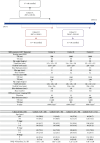A Longitudinal Correlational Study of Psychological Resilience, Depression Disorder, and Brain Functional-Structural Hybrid Connectome in Breast Cancer
- PMID: 40226657
- PMCID: PMC11918802
- DOI: 10.1155/2024/9294268
A Longitudinal Correlational Study of Psychological Resilience, Depression Disorder, and Brain Functional-Structural Hybrid Connectome in Breast Cancer
Abstract
Purposes: To evaluate the association between psychological resilience, depression disorder (DD), and brain functional-structural hybrid connectome in patients with breast cancer before treatment (T0) and at 1 year. Methods: Between February 2017 and October 2019, 172 patients were longitudinally enrolled from a multicenter trial named as Be Resilient to Breast Cancer (BRBC) and completed resting-state functional magnetic resonance imaging (rs-fMRI) and diffusion tensor imaging (DTI) before the T0. Data-driven multivoxel pattern analysis (MVPA) and correlational tractography (CT) were performed to identify distinct functional-structural hybrid connectome. DD was diagnosed by psychiatry physicians according to Diagnostic and Statistical Manual of Mental Disorders, Fifth Edition (DSM-5). Psychological resilience was collected by Resilience Scale Specific to Cancer (RS-SC) and tested as the mediation variable between hybrid connectome and DD. Results: Of the total sample of 172, 14.5% (N = 25) were diagnosed with DD. High psychological resilience was associated with a lower risk of DD (hazard ratio (HR) = 0.37, 95% confidence interval (CI), 0.17-0.82, p=0.0368). Frontal pole right (88.0%) in rs-fMRI and arcuate fasciculus_L (75.2%) in DTI were identified as main significant brain areas. Psychological resilience accounted for 10.01%-12.14% of direct effect between brain functional-structural hybrid connectome and 1-year DD. Conclusion: Psychological resilience predicts DD at 1 year and mediates the association between brain functional-structural hybrid connectome and DD at 1 year in patients diagnosed with breast cancer. Trial Registration: ClinicalTrials.gov identifier: NCT03026374.
Keywords: Be Resilient to Breast Cancer; brain functional–structural hybrid connectome; breast cancer; depression disorder; psychological resilience.
Copyright © 2024 Mu Zi Liang et al.
Conflict of interest statement
The authors declare no conflicts of interest.
Figures





References
-
- Allemani C., Matsuda T., Di Carlo V., et al. Global Surveillance of Trends in Cancer Survival 2000-14 (CONCORD-3): Analysis of Individual Records for 37 513 025 Patients Diagnosed With One of 18 Cancers From 322 Population-Based Registries in 71 Countries. Lancet . 2018;391(10125):1023–1075. doi: 10.1016/S0140-6736(17)33326-3. - DOI - PMC - PubMed
-
- Hartung T. J., Brähler E., Faller H., et al. The Risk of Being Depressed Is Significantly Higher in Cancer Patients Than in the General Population: Prevalence and Severity of Depressive Symptoms Across Major Cancer Types. European Journal of Cancer . 2017;72:46–53. doi: 10.1016/j.ejca.2016.11.017. - DOI - PubMed
-
- Andersen B. L., DeRubeis R. J., Berman B. S., et al. American Society of Clinical Oncology. Screening, Assessment, and Care of Anxiety and Depressive Symptoms in Adults with Cancer: An American Society of Clinical Oncology Guideline Adaptation. Journal of Clinical Oncology . 2014;32(15):1605–1619. doi: 10.1200/JCO.2013.52.4611. - DOI - PMC - PubMed
Publication types
MeSH terms
Associated data
LinkOut - more resources
Full Text Sources
Medical

